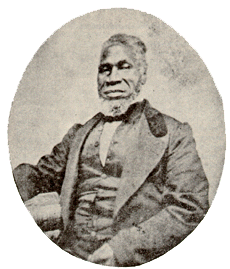

In The Key to Uncle Tom's Cabin, in support of her characterization of Tom as a Christian hero, Stowe quotes several passages from Josiah Henson's 1849 narrative of his enslavement and escape. In 1858 she wrote a preface to Henson's revised and expanded autobiography, Father Henson's Story of His Own Life. After the Civil War, Henson and his supporters parlayed these Stowe connections into the claim that he was Uncle Tom -- that Stowe had based her hero directly on Henson's character and the stories he told her about slavery. The title of the third and final edition of his life, published in 1879, is An Autobiography of the Rev. Josiah Henson (Mrs. Harriet Beecher Stowe's "Uncle Tom").
You can look more closely at these claims, and the evidence they're based on, in the AFRICAN AMERICAN RESPONSES section of the archive. Here is about half of Henson's original autobiography, published three years before Uncle Tom's Cabin. As the ADVERTISEMENT that appeared as a preface to the text explains, the autobiography was "written from the [Henson's] dictation." Henson's ghost writer was Samuel A. Eliot, a former mayor of Boston. Like all the fugitive slave narratives, this text is intended to expose the evils of slavery. It was also intended to help Henson raise money for the Dawn community, the school for former slaves Henson had founded in Canada West (now called Ontario).
The Life of Josiah Henson, Formerly a Slave, Now an Inhabitant of Canada. Narrated by Himself. (Boston: Arthur D. Phelps, 1849)
[Pages 27-37. Now living in Kentucky and working for Amos Riley (called "R." in this 1849 text), Henson meets a white Methodist preacher, who encourages him to buy his own freedom, and helps him devise a means to do so. Henson travels back to Maryland to meet with Isaac Riley, preaching to white Methodist congregrations and raising money on the way. He arranges with Riley to buy himself for $450, but upon returning to Kentucky finds that his master has deceived him, tricking him out of $350 and leaving him a slave. "I consoled myself at well as I could . . . resolved to trust in God, and never despair."]
[Pages 44-60. He knows he is on the verge of being sold in New Orleans when Amos Riley, Jr., falls seriously ill and depends on Henson to carry him back to Kentucky. There Henson decides to escape to freedom, although it takes some time to convince his wife to accompany him along with their four children. The family is rowed across the Ohio by a fellow slave, helped in the Ohio wilderness by an Indian tribe, and carried from Sandusky to Canada by the captain of a freight boat. Arriving in Canada on October 28, 1830, he finds work almost immediately as a day laborer.]
[Pages 68-76. After several years pioneering on new land, while making periodic trips back into Maryland and Kentucky to bring other slaves back to Canada with him, Henson finds white sponsors for the idea of his black community at Dawn. He buys land and founds the manual labor school.]
